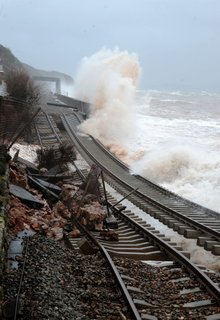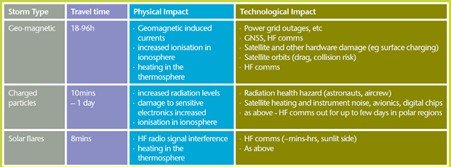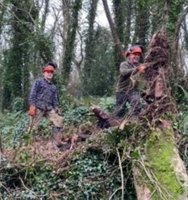RYDA Newsletter 03/2022
STORMS
Storms have the potential to harm lives and property via storm surge, heavy rain or snow causing flooding or road impassibility, lightning, wildfires, and vertical and horizontal wind shear. Systems with significant rainfall and duration help alleviate drought in places they move through. Heavy snowfall can allow special recreational activities to take place which would not be possible otherwise, such as skiing and snowmobiling.
Storms are created when a centre of low pressure develops with the system of high pressure surrounding it. This combination of opposing forces can create winds and result in the formation of storm clouds such as cumulonimbus. Small localized areas of low pressure can form from hot air rising off hot ground, resulting in smaller disturbances such as dust devils and whirlwinds.
Storms can cause huge damage, not only to property, infrastructure, but also to sea beds.
Scientists studied the return of life to the Lyme Bay Marine Protected Area (MPA), damaged in 2013 and 2014.
The zone, which runs from near Exmouth in Devon along the Dorset coast, was monitored by underwater cameras.
They said "extreme" storms are increasing in strengthen and frequency because of climate change.
The storms which struck the south coast of England in the winter of 2013 and 2014 were the most powerful since 1948.
Seafront walls around Devon were destroyed, and vehicles damaged by high winds.
What about the famous storm of 2014, which completely destroyed the rail track at Dawlish, leaving much of South Devon inaccessible by train. (8 years ago – where has time gone!)
Who remembers “The Beast from the East”? Much of winter 2018 was generally mild (much like this year), but things changed dramatically during the last week of February as the UK experienced a prolonged cold snap, with widespread heavy snow. It lasted for 10 days and was compounded by the arrival of Storm Emma.
By 27 February, the mercury dropped to -11.7C overnight and many areas stayed below freezing all day. The weather system saw Devon and Cornwall grind to a halt, , with heavy snow blocking our roads and closing our schools.

By 4 March, temperatures slowly started to rise, but this brought a new hazard. Snow melt combined with high tides and flooding became a major issue. Frozen pipes burst as they thawed, leading to water supply problems. The clean-up was costly and the severe weather was responsible for a total of 10 deaths in the UK.
Storms not only occur on earth.
Space weather describes changing environmental conditions in near-Earth space. Magnetic fields, radiation, particles and matter, which have been ejected from the Sun, can interact with the Earth’s upper atmosphere and surrounding magnetic field to produce

The most recognisable and visible space weather effect is arguably the auroras (Northern and Southern Lights). However, as well as these spectacular natural phenomena, space weather also represents a real threat and can have an impact upon national infrastructure, technology, and communications systems.
The threat of space weather to national infrastructure, UK industry and the wider public is such that in 2011 it was added to the Government National Risk Register of Civil Emergencies.
SpaceX’s newest fleet of satellites is tumbling out of orbit after being struck by a solar storm. Up to 40 of the 49 small satellites launched in February 2022 have either re-entered the atmosphere and burned up, or are on the verge of doing so, the company said. It is due to a geomagnetic storm which made the atmosphere denser, increasing the drag on the satellites, effectively dooming them.
What causes space weather?
Space weather is a consequence of the behaviour of the Sun, the nature of Earth’s magnetic field and atmosphere, and our location in the solar system. The active elements of space weather are particles, electromagnetic energy and magnetic fields, rather than the more commonly known weather contributors of water, temperature and air. Magnetic fields, radiation, particles and matter which have been ejected from the Sun can interact with the Earth’s magnetic field and upper atmosphere to produce a variety of effects.
Solar flares are the sudden releases of energy across the entire electromagnetic spectrum. They are hard to predict, and the energy can be detected in Earth's atmosphere as soon as 8.5 minutes after the occurrence of a solar flare.
Radio blackouts
The ionosphere is a dynamic part of the upper atmosphere which acts as a reflector for long range, high frequency communications (HF comms). During a solar flare the increase in x-ray radiation from the Sun causes the ionosphere to absorb rather than reflect signals and this disrupts communications systems on the sun-lit side of the Earth. The Sun may also emit radio bursts at multiple wavelengths causing various problems for communication and navigation systems.
Even during periods of quiet solar activity turbulence in the ionosphere can result in a scattering of electromagnetic waves disrupting navigation systems like Global Navigation Satellite Systems (GNSS) often known as Global Positioning System (GPS) and radio bands up to the GHz frequencies. These are referred to as radio blackouts.


Then we have these:- Storms in a teacup. Many such storms are, in reflection, over nothing important, but have the potential to cause lasting hurt.
I suspect politicians will be thinking - Don’t worry. It’s a storm in a teacup.(or wine glass) Everyone will have forgotten about it by tomorrow.
With the sad events happening in Ukraine, they are probably right.

RYDA AGM
Noss Village Hall
12th April 2022 @ 7pm
Please come and join us
It will be our first in-person AGM since lockdown began.
Come and meet the new Chairman & Secretary
A zoom link will be available
TWINNING with TREBEURDEN
A PUBLIC MEETING followed by the ANNUAL GENERAL MEETING will be held at the WI Community Hall, Parsonage Road, Newton Ferrers on 22 March 2022 at 1900.
Newton and Noss have been Twinned with Trebeurden in North Brittany since 2010. The Twinning Association has been on hold for a couple of years. Now the Plymouth/Roscoff Ferry is coming back into service and the Coronavirus position is improving, we are firing the Twinning back up.
If you have any interest in Twinning at all, please do come along to the meeting. Andrew Matthews (872942)







Learn a facinating and ancient craft

RYHA
Boats are scheduled to be lifted back in from Bridgend quay on the 30th March 2022. There is a 5m tide at 1800.
Nobody will be allowed on the quay during crane in for safety reasons. All cradles will need to be removed from the quay as soon as possible after lift in to enable summer dinghy storage.

As usual your garden waste bin will be emptied the opposite week to your grey bin. From 25 March, you can double check when your next collection day will be through the Council’s website.
Make sure your bin is not too heavy
To make sure as many bins as possible can be emptied quickly and efficiently, please make sure bins are not too heavy for staff to collect safely. There are weight restrictions on the bin lifts and compacted garden waste can become heavy when it starts breaking down.
If a bin is too heavy, it is at risk of being rejected. Therefore, please remove some of the garden waste before collection is due and save this for the next collection date. Only one brown bin will be collected so crews can get around as many properties as possible, as quickly as they possibly can.

South Hams District Council’s contracted garden waste service is restarting in the spring, just in time for residents to make the most of the growing season by recycling their garden waste.
FCC Environment Ltd, who operate the service on behalf of the District Council, will begin collections once again from the week beginning Monday 28 March.
The fortnightly service was reluctantly, and temporarily, suspended in August 2021 due to the severe national driver shortages, which caused issues for all business sectors across the country, to lessen the impacts to the waste, recycling and clinical collections. Since then, a recruitment campaign has managed to recruit more drivers and loaders allowing the garden waste collections to restart.

Harbour Clean Up
Last year’s harbour clean up was a victim of Covid, but this year’s clean-up is planned to take place on Saturday 30th April 2022.
It will, once again, be run by Andrew Beveridge who is very keen to attract more volunteers.



Plymouth Music Accord is a Registered Charity supporting the appreciation and performance of music around Plymouth for the benefit of all and the young in particular. They fund raise to provide lessons, scholarships and instruments to School children. For upcoming events see What's On This Month .....


Newton & Noss Village Hall 200 Club Lottery – 2022 Update and March 2022 Draw Results.
A big thanks to everyone who has joined the lottery draw from April 2021 and to the local businesses who kindly contributed prizes to supplement the cash awards – Dolphin Inn, Luscombe Maye, Marchand Petit, Noss Beer Works, Bridgend Bike Services and Trevor, the Newton butcher.

Our first year saw 50 winners and the funding of the replacement of the rotten sleepers with a new drystone wall in the Village Hall garden.
There is still time to join the lottery for April 2022. To join for the first draw, just enter your details on http://www.nnvh.org.uk/lottery.php or contact Roger on 873276 or Sharon on 873353 if you would like an application form to be delivered to you and/or collected from you or if you have any queries. The cost is £20 per number to gain entry into the twelve monthly draws. You can buy one or as many numbers as you like. This year we have even more additional donated prizes in addition to the cash awards. In 2022 we hope to fund the replacement of the Village Hall boiler.
Finally, congratulations to the winners in the last monthly draw in March 2022.
1st Prize (£50) 151. Janet Shepherd
2nd Prize (£30) 20. Sheila Finch
3rd Prize (£20) 166. Alison Ansell
4th Prize (£20 voucher for the Dolphin Inn, kindly donated by Jonathan Rhead and Nicky Bullock) 161. John Ingram
Thank you very much for your support.



NEWTON AND NOSS VILLAGE HALL ANNUAL MEETING
The next Annual meeting of the Newton and Noss Village Hall will be held on Tuesday May 3rd 2022 at 7pm in the Revelstoke Room. Full details will be available nearer the time, but please do save the date, and join us.
Brookings Down Wood &
Eastern Hill Wood
As the warmth of early Spring starts to stimulate growth and wildlife activity in both woods, we are fast approaching the point where our planned Autumn to Spring working parties come to a close to allow nature to do its own thing! Early signs suggest we could see a bumper year for Bluebells within a couple of months.


Since our last update both woods have taken poundings from several winter storms with the loss of a number of large well established trees of which 9 Ash needed to be professionally felled due to advanced Ash Dieback, these were then cut up and cleared by our trusty band of volunteers. Therefore our program of planting new trees has particular relevance to future proof both woods and make up for our losses but also add new and diverse species and to this end we have recently planted 10 Hornbeam and 20 Hazel saplings splitting them between both woods.
Particular thanks are due to those volunteers who came at short notice to remove the sycamore blocking two paths following the recent storm.
Thanks as well to Roger Ball for his invaluable input and support, sadly he will be standing down from the committee and moving away from the village, shortly.
Thanks also to Jonathan Rundle , David Blythman and Steve Green for donating and fixing 15 new nest boxes in BDW.
Spring maintenance program finishes on April 2nd then during the summer we will just maintain the paths as necessary.
Please come and enjoy the Bluebells towards the end of April and early May.
If you would like to know more about becoming a Friend of the woods or joining a future working party please contact:
Paul Francombe (thefrancombes@btinternet.com
Or Val Lomax (val@lomcroft.plus.com
Brookings Down & Eastern Hill Management Committee

RYDA Planning
Although there is little of significance in this month’s Planning Applications, one item of interest is an application to remove part of the stone boundary wall at Linden Lea on Yealm Road opposite Holy Cross Church. This would enable the installation of a vehicle gate and parking area. The reference for this is: 0305/22/HHO
The Highway Authority (Devon County Council) have objected on the grounds of inadequate visibility splays and lack of turning space in the proposed parking area to allow cars to enter and leave in forward gear. Several neighbouring properties have similar parking areas, not all have space for turning. Balanced against the loss of garden habitat, this proposal would obviate some on-street parking. Whilst traffic speeds here are generally low and there are no recorded accidents, is this a reasonable objection?
Collaton
We understand that the SHDC Development Management Committee are due to discuss at their meeting in May 2022, and possibly decide on, the application for 125 new houses plus commercial units and parkland at Collaton. Our local District Councillor on the committee is Daniel Brown, who, if you have any views on the proposal, could be contacted by email: Cllr.Daniel.Brown@southhams.gov.uk






